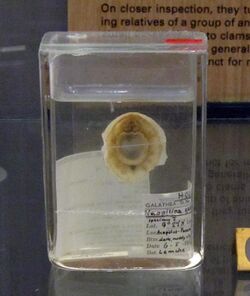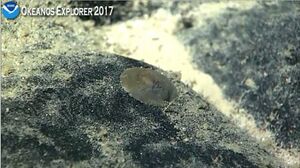Biology:Neopilina
| Neopilina | |
|---|---|

| |
| The holotype of N. galatheae at the Zoological Museum, Copenhagen | |
| Scientific classification | |
| Domain: | Eukaryota |
| Kingdom: | Animalia |
| Phylum: | Mollusca |
| Class: | Monoplacophora |
| Order: | Neopilinida |
| Family: | Neopilinidae |
| Genus: | Neopilina Lemche, 1957 |
| Species | |
|
4 species (see text) | |
Neopilina is a highly derived genus of modern monoplacophoran.[1][2]
Species
Four species are recognized:[2]
- Neopilina bruuni Menzies, 1968
- Neopilina galatheae Lemche, 1957
- Neopilina rebainsi Moskalev, Starobogatov & Filatova, 1983
- Neopilina starobogatovi Ivanov & Moskalev, 2007
Phylogeny
Some molecular results show that they fall within the polyplacophoran clade,[3] although these results have been called into question.[4] Fossil and morphological data show that they are rather derived and bear very little resemblance to an 'ancestral mollusc'.[1]
Anatomy
Its anatomy[5] led researchers to believe that the cephalopods evolved from the Monoplacophora.[5]
Its pair of preoral tentacles are considered homologous to those of gastropods; like prosobranch gastropod tentacles, their nerves connect to the cerebral ganglia.[5] The post-oral tentacles are equated with bivalves' labial flaps, cephalopods' arms, and scaphopods' captacula.[5]
Cuticular hardenings around the mouth of the organism are considered to be jaw-like and not far removed from the beaks of cephalopods or the jaws of many gastropods.[5]
The presence of a single shell prompts comparisons to the cephalopod Nautilus, but besides its bilateral symmetry and direction of coiling, there is not a clear equivalence; Nautilus' shell is notably different in the possession of septa (and thus a siphuncle).[5]:64 It bears a similar degree of similarity to most other mollusc groups, leading to speculation that it may reflect a relatively unchanged ancestral mollusc.[5] The shell itself is aragonitic, consisting mainly of a prismatic layer,[6] lined with nacre.[5]
The organism bears five pairs of ctenidia (gills), unusually for molluscs; the rear two are homologous to the two pairs in Nautilus. This is unlike the Polyplacophora (chitons), which have a number of pairs of ctenidia, but this number varies and is not related to the number of their body 'segments'.[5]
The foot and pallial groove are very difficult indeed to discriminate from the polyplacophora,[5] supporting its placement in this group by molecular methods[3]
Its radula is not unlike that of the polyplacophora; notably, its fifth tooth is modified to be comb-like.[7]
Ecology
Neopilina is a bottom feeder, probably a deposit feeder; whilst alive, its shell is covered by a layer of mucus that might be involved in feeding or locomotion.[8]
In 2017, a deep-sea expedition by the Okeanos Explorer off the coast of American Samoa filmed the first-ever high-resolution video of a monoplacophoran in its natural habitat. Two Neopilina sp. individuals were filmed on the ocean floor. The individuals may belong to an undescribed species, with five pairs of long gills clearly visible.[9]
References
- ↑ Jump up to: 1.0 1.1 Organisms, Genes and Evolution: Evolutionary Theory at the Crossroads ; Proceedings of the 7th International Senckenberg Conference. By Dieter Stefan Peters, Michael Weingarten. Contributor: Dieter Stefan Peters. Published by Franz Steiner Verlag, 2000. ISBN:3-515-07659-X, 9783515076593. 243 pages.
- ↑ Jump up to: 2.0 2.1 "Neopilina Lemche, 1957". MolluscaBase. World Register of Marine Species. 2023. http://www.marinespecies.org/aphia.php?p=taxdetails&id=343675.
- ↑ Jump up to: 3.0 3.1 Giribet, G.; Okusu, A, A.; Lindgren, A.R., A. R.; Huff, S.W., S. W.; Schrödl, M, M.; Nishiguchi, M.K., M. K. (May 2006). "Evidence for a clade composed of molluscs with serially repeated structures: monoplacophorans are related to chitons". Proceedings of the National Academy of Sciences of the United States of America 103 (20): 7723–7728. doi:10.1073/pnas.0602578103. PMID 16675549. Bibcode: 2006PNAS..103.7723G.
- ↑ Wägele, J Wolfgang (2009). "Phylogenetic support values are not necessarily informative: the case of the Serialia hypothesis (a mollusk phylogeny)". Frontiers in Zoology 6 (12): 12. doi:10.1186/1742-9994-6-12. PMID 19555513.
- ↑ Jump up to: 5.0 5.1 5.2 5.3 5.4 5.5 5.6 5.7 5.8 5.9 Lemche, H; Wingstrand, K.G. (1959). "The anatomy of Neopilina galatheae Lemche, 1957 (Mollusca, Tryblidiacea)". Galathea Report 3: 9–73. https://digit.snm.ku.dk/Documentsonline/GalatheaReports/galathea-vol.03-pp_009-072.pdf.
- ↑ Weiner, Stephen; Addadi, Lia (1997). "Design strategies in mineralized biological materials". Journal of Materials Chemistry 7 (5): 689–702. doi:10.1039/A604512J. http://www.rsc.org/ej/JM/1997/a604512j.pdf. – contains spectacular SEM of prismatic nature of aragonite shell
- ↑ Wingstrand, Karl Georg. "On the anatomy and relationships of recent Monoplacophora". Galathea Report 16: 7–94. https://digit.snm.ku.dk/Documentsonline/GalatheaReports/galathea-vol.16-pp_007-094.pdf.
- ↑ Menzies, R. J.; Ewing, M.; Lamar Worzel, J.; Clarke, A. H. (1959). "Ecology of the recent Monoplacophora". Oikos 10 (2): 168–182. doi:10.2307/3565144.
- ↑ Sigwart, Julia D.; Wicksten, Mary K.; Jackson, Matthew G.; Herrera, Santiago (2019). "Deep-sea video technology tracks a monoplacophoran to the end of its trail (Mollusca, Tryblidia)". Marine Biodiversity 49 (2): 825–832. doi:10.1007/s12526-018-0860-2.
External links
- Video of Neopilina sp. Footage taken by ROV Deep Discoverer, NOAA 2017 American Samoa Expedition (EX-17-02), dive 08 at ‘Utu’ seamount, 3837 m depth.
Wikidata ☰ Q865430 entry
 |


